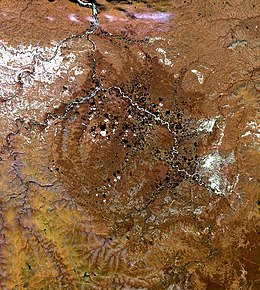Popigai impact structure
| Popigai crater | |
|---|---|
 Landsat image of Popigai crater | |
| Impact crater/structure | |
| Confidence | Confirmed |
| Diameter | 90 km (56 mi) |
| Impactor diameter | 5 ± 2 kilometers (3.1 ± 1.2 mi) |
| Age | 35.7 ± 0.2 Ma Late Eocene |
| Exposed | Yes |
| Drilled | Yes |
| Bolide type | H chondrite [1] |
| Location | |
| Coordinates | 71°39′N 111°11′E / 71.650°N 111.183°E |
| Country | |
| State | Krasnoyarsk |
The Popigai crater (or astrobleme) in Siberia, Russia is tied with the Manicouagan Crater as the fourth largest verified impact crater on Earth.[2][3] A large bolide impact created the 100-kilometre (62 mi) diameter crater approximately 35 million years ago during the late Eocene epoch (Priabonian stage).[4][5] It is conjectured that it may have influenced the Eocene–Oligocene extinction event.[6]
The crater is 300 km (190 mi) east from the outpost of Khatanga and 880 km (550 mi) northeast of the city of Norilsk. It is designated by UNESCO as a Geopark, a site of special geological heritage.[7] There is a small possibility that the Popigai impact crater may have formed simultaneously with the approximately 35-million-year-old Chesapeake Bay and Toms Canyon impact craters.[4]
For decades the Popigai crater has fascinated paleontologists and geologists, but the entire area was completely off limits because of the diamonds found there and the mines constructed by gulag prisoners under Stalin. However, a major investigatory expedition was undertaken in 1997, which greatly advanced understanding of the enigmatic structure.[7] The impactor in this event has been identified as either an 8 km (5.0 mi) diameter chondrite asteroid, or a 5 km (3.1 mi) diameter stony asteroid.
The shock pressures from the impact instantaneously transformed graphite in the ground into diamonds within a 13.6 km (8.5 mi) radius of the impact point. These diamonds are usually 0.5 to 2 mm (0.020 to 0.079 in) in diameter, though a few exceptional specimens are 10 mm (0.39 in) in size. The diamonds not only inherited the tabular shape of the original graphite grains but they additionally preserved the original crystals' delicate striations.[7]
Diamond mines

Most modern industrial diamonds are produced synthetically, so the deposits at Popigai may not be profitable because of the remote location and difficulty of extraction.[9] Many of the diamonds at Popigai contain crystalline lonsdaleite, an allotrope of carbon that has a hexagonal lattice.[10] Pure, laboratory-created lonsdaleite is 58% harder than ordinary diamonds,[11] though it is unknown whether the natural, impure examples at Popigai show similar characteristics.[9] The diamonds also "contain unusual abrasive features and large grain size" which could make them extremely useful for industrial and scientific applications. These types of diamonds are known as "impact diamonds" because they are thought to be produced when a meteorite strikes a graphite deposit at high velocity.[10] They may have industrial uses but are considered unsuitable as gems.[12]
Additionally, carbon polymorphs even harder than lonsdaleite have been discovered in the crater.[13]
See also
- List of impact craters on Earth
- List of unconfirmed impact craters on Earth – for unconfirmed craters similar to or larger than Popigai
- Logancha crater
References
- ^ Schmitz, Birger; Boschi, Samuele; Cronholm, Anders; Heck, Philipp R.; Monechi, Simonetta; Montanari, Alessandro; Terfelt, Fredrik (2015). "Fragments of Late Eocene Earth-impacting asteroids linked to disturbance of asteroid belt". Earth and Planetary Science Letters. 425: 77–83. Bibcode:2015E&PSL.425...77S. doi:10.1016/j.epsl.2015.05.041. ISSN 0012-821X.
- ^ "Popigai". Earth Impact Database. Planetary and Space Science Centre University of New Brunswick Fredericton. Retrieved 2017-10-09.
- ^ Masaitis, Victor L. (2003). Popigai Crater: General Geology. Springer. pp. 81–85. ISBN 978-3-540-43517-4.
- ^ a b Deutsch, Alexander; Christian Koeberl (2006). "Establishing the link between the Chesapeake Bay impact structure and the North American tektite strewn field: The Sr-Nd isotopic evidence". Meteoritics & Planetary Science. 41 (5): 689–703. Bibcode:2006M&PS...41..689D. doi:10.1111/j.1945-5100.2006.tb00985.x. Retrieved 2008-06-16.
{{cite journal}}: Check|url=value (help)[permanent dead link] - ^ Armstrong, Richard; S. Vishnevsky; C. Koeberl (2003). U-Pb Analysis of zircons from the Popigai impact structure, Russia: First Results. Springer. pp. 99–116. ISBN 978-3-540-43517-4.
- ^ "Russia's Popigai Meteor Crash Linked to Mass Extinction". June 13, 2014.
- ^ a b c Deutsch, Alexander; V.L. Masaitis; F. Langenhorst; R.A.F. Grieve (2000). "Popigai, Siberia—well preserved giant impact structure, national treasury, and world's geological heritage". Episodes. 23 (1): 3–12. Retrieved 2014-04-06.[permanent dead link]
- ^ Ohfuji, Hiroaki; Irifune, Tetsuo; Litasov, Konstantin D.; Yamashita, Tomoharu; Isobe, Futoshi; Afanasiev, Valentin P.; Pokhilenko, Nikolai P. (2015). "Natural occurrence of pure nano-polycrystalline diamond from impact crater". Scientific Reports. 5: 14702. Bibcode:2015NatSR...514702O. doi:10.1038/srep14702. PMC 4589680. PMID 26424384.
- ^ a b "Diamonds Beneath the Popigai Crater -- Northern Russia". geology.com. 23 September 2012. Retrieved 24 September 2012.
- ^ a b "Russia declassifies deposit of impact diamonds". ITAR-TASS. 17 September 2012. Retrieved 17 September 2012.
- ^ Pan, Zicheng; Sun, Hong; Zhang, Yi; Chen, Changfeng (2009). "Harder than Diamond: Superior Indentation Strength of Wurtzite BN and Lonsdaleite". Physical Review Letters. 102 (5): 055503. Bibcode:2009PhRvL.102e5503P. doi:10.1103/PhysRevLett.102.055503. PMID 19257519.
{{cite journal}}: Unknown parameter|last-author-amp=ignored (|name-list-style=suggested) (help); Unknown parameter|laydate=ignored (help); Unknown parameter|laysource=ignored (help); Unknown parameter|laysummary=ignored (help) - ^ Pros and cons of extraterrestrial diamonds Archived 2014-12-22 at the Wayback Machine, from "Rough&Polished–information and analytics on diamond and jewellery markets."
- ^ El Goresy, Ahmed; Dubrovinsky, Leonid S; Gillet, Philippe; Mostefaoui, Smail; Graup, Günther; Drakopoulos, Michael; Simionovici, Alexandre S; Swamy, Varghese; Masaitis, Victor L (2003). "A new natural, super-hard, transparent polymorph of carbon from the Popigai impact crater, Russia". Comptes Rendus Geoscience. 335 (12): 889. Bibcode:2003CRGeo.335..889E. doi:10.1016/j.crte.2003.07.001.



